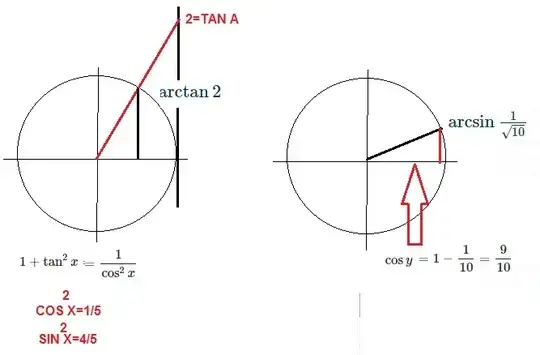First I denote $x=\arctan{2}$ and $y=\arcsin{\frac{1}{\sqrt{10}}}$ and then use the addition formula for sine:
$$\sin{(x-y)}=\sin{x}\cos{y}-\cos{x}\sin{y}=\sin{x}\cos{y}-\cos{x}\cdot \frac{1}{\sqrt{10}}.$$
Now I use the fact that $\cos{y}=1-\sin^2{y}$ which gives
$$\cos{y}=1-\sin^2{\left(\arcsin{\frac{1}{\sqrt{10}}}\right)}=1-\frac{1}{10}=\frac{9}{10}$$
So I have reduced the problem to the following
$$\sin{x}\cdot \frac{9}{10}-\cos{x}\cdot \frac{1}{\sqrt{10}}.$$
Here I'm stuck. I cant just divide this expression by $(\sin{x}\cos{x})$ because I'd still be left with sine and cos terms and I'd also change the value of the expression. Everything now boils down to compute $\sin(\arctan{2})$ and $\cos{\arctan2}.$ I also tried rewriting $\cos(\arctan{2})$ as $1-\sin^2(\arctan{2}),$ but to no avail.
Any suggestions on
- how to proceed from where I left;
- how tocompute this by means more effective;
- both of the above.
